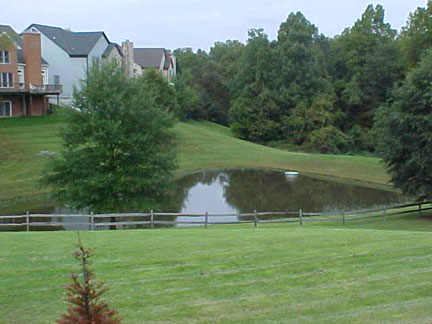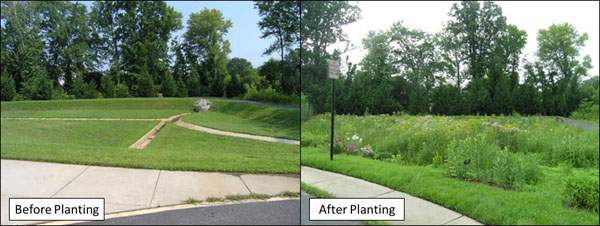 Stormwater ponds capture, control and filter runoff from roofs, roads and parking lots before it enters our local streams. In Fairfax County, the construction of stormwater ponds became a requirement for new development in the 1980s. Today, there are at least 2,000 stormwater ponds in Fairfax County; over half are maintained by the county and the remaining ponds are privately maintained.
Stormwater ponds capture, control and filter runoff from roofs, roads and parking lots before it enters our local streams. In Fairfax County, the construction of stormwater ponds became a requirement for new development in the 1980s. Today, there are at least 2,000 stormwater ponds in Fairfax County; over half are maintained by the county and the remaining ponds are privately maintained.
Why control runoff? When new roads and buildings are built, the increased amount and velocity of runoff can damage nearby streams. Streams will rise to new peak flows (the maximum amount of discharge after a rain or snow). If unmanaged, stream banks begin to erode under the increased flows. Sediment (soil), excess nutrients and other pollutants are carried downstream, negatively affecting aquatic life.
Stormwater ponds slow the flow of water, filter pollutants and improve stream health. Along with riparian buffers, rain gardens and other infiltration practices, they are an important tool to help protect local streams.
Wet Ponds and Dry Ponds
There are two general types of stormwater ponds: wet ponds and dry ponds.
How can a pond be dry? A dry pond is designed to hold water for a short period of time before allowing the water to discharge to a nearby stream. Dry ponds control peak flows of runoff, help improve water quality and lessen the effects of erosion. Between rain events, a dry pond looks like a large, grassy low area. When it rains, the pond fills with water. They hold water for 48-72 hours to allow sediment and pollutants to settle out. Because they detain water for a brief time before allowing it to flow out, dry ponds are also called detention ponds.
Wet ponds, on the other hand, maintain a permanent pool of water throughout the year. They remove pollutants by allowing sediment to settle as water slowly moves from one end of the pond to the other and through biological uptake, as plants absorb excess nutrients. Wet ponds frequently have smaller pools, plants and a wetland area. Wet pond water levels can increase dramatically as a result of rainstorms, like dry ponds. Because they retain water for a longer time, wet ponds are also called retention ponds.
Both wet and dry ponds remove sediment, phosphorus and other pollutants. Because water stays in them longer, wet ponds typically are able to remove more pollutants. Dry ponds are more common, however. They are less expensive to install, require less maintenance and may involve less liability for the communities around them.
Stormwater Pond Retrofits
Many older county maintained stormwater ponds are being renovated so that they work more effectively in managing the quantity of stormwater runoff. For example, sometimes a stormwater pond will be resized to fit new conditions when a neighborhood grows. A larger stormwater pond can hold more water and store runoff for longer periods of time.
Some stormwater ponds also are being redesigned to improve their pollutant removal efficiency. A shallow permanent pool (often called a sediment forebay) may be added to trap silt and sediments and improve pollutant removal. Stormwater ponds are occasionally dredged, removing excess sediment that has built up throughout the years. The addition of a sediment forebay in a pond makes dredging quicker and easier since the sediment is confined to a small space. A small wetland area can provide essential habitat and further water filtration. Native plants and wildflowers are added, promoting nutrient uptake and stimulating ecosystem development.
At first, these changes can be unwelcome in a neighborhood. Residents may not be aware that these previously mowed, grassy areas are stormwater management facilities. Even though the county warns against using stormwater ponds for recreation, some people do. Some also worry about insects. (Ponds are actually not good mosquito breeding sites. See below: What about Mosquitoes? to learn why.) Once neighbors understand why their stormwater ponds are undergoing these changes, most come to accept and even enjoy the amenity.
After all, these pond retrofits are part of a bigger idea: helping streams to return to their natural pre-development flow. Before the roads, roofs and parking lots found all over Fairfax County today were built, this area was mostly farmland and wooded areas. These green areas allowed water to filter into the ground slowly, recharging groundwater and having a lighter impact on streams. With increased development over recent decades, stream quality has degraded. Recent efforts to restore streams naturally have focused on slowing runoff down, spreading it out, and soaking it into the ground.
The purpose of stormwater ponds is to control excess stormwater runoff and improve water quality to nearby streams. When enhanced with plantings, they can be attractive and increase residential property value. They can provide habitat to attract turtles, frogs, butterflies and birds that also help improve our own quality of life.

Stormwater Pond Questions and Answers
Here are some answers to common questions about stormwater ponds.
1. The Trash Rack: What is That?
In both dry and wet ponds, there is a screening device attached to the control structure which prevents trash and other debris from leaving the pond and entering the stream. The county does not remove trash from ponds. If the trash rack gets so clogged with litter, leaves, and grass clippings that the water cannot freely pass through it, then the facility will not function properly. In both dry and wet ponds, there is a screening device attached to the control structure which prevents trash and other debris from leaving the pond and entering the stream. If the trash rack gets so clogged with litter, leaves and grass clippings that the water cannot freely pass through it, then the facility will not function properly.
2. Why Are There Warning Signs?
Stormwater ponds are essentially designed to “flash flood.” If it is raining in the watershed, water can accumulate in the pond very quickly. Don’t go in the pond when it’s raining!
3. What about Mosquitoes?
It may seem counter-intuitive, but stormwater ponds with pools or permanent wet areas are not good breeding sites for mosquitoes. Why? These ponds have mosquito predators such as fish, frogs and dragonflies. These predators feed on mosquito adults and larvae, and successful female mosquitoes will find a safer place to lay their eggs.
The Fairfax County Health Department offers recommendations for controlling mosquitoes. Top mosquito breeding sites include sagging or clogged gutters. Mosquitoes are not able to fly very far, so if they attack when you walk out the door, check gutters and any downspout extensions first. The Fairfax County Health Department has an inspection and treatment program for mosquito control - search for mosquito, 703-246-8931, TTY 711.
4. Who Owns the Pond?
Publicly maintained dry ponds often exist on privately owned land. While the county maintains the pond area, it is the land owners’ responsibility to perform routine maintenance outside the pond easement. Publicly maintained ponds have easements for county maintenance access that have to be kept clear of obstructions. No structures are permitted within an easement. Wet ponds often are maintained by the private company or homeowners’ association where they are located. The property owners are required to follow county maintenance guidelines.
Learn More
For more information about stormwater ponds, see:
- Stormwater Maintenance and Inspections
- Wet and Dry Stormwater Management Ponds
- Report a Stormwater Pond Maintenance Complaint
This article was authored by Emily Burton (Nee McVearry), a NVSWCD intern and a graduate student in Environmental Management at University of Maryland.

